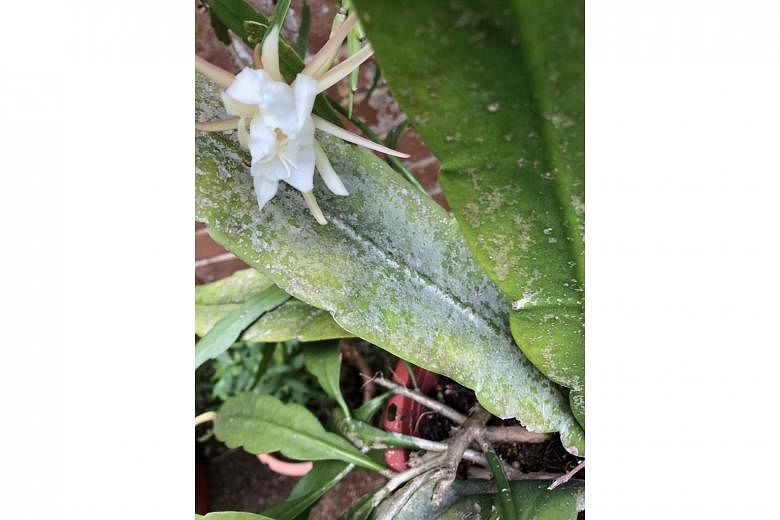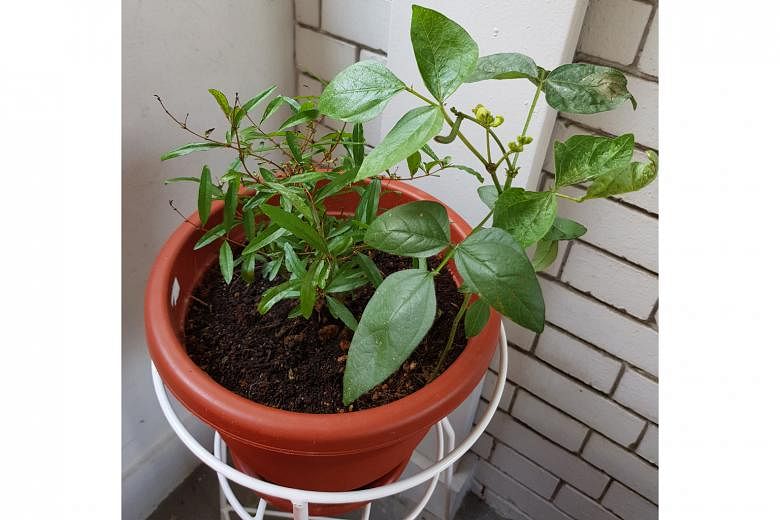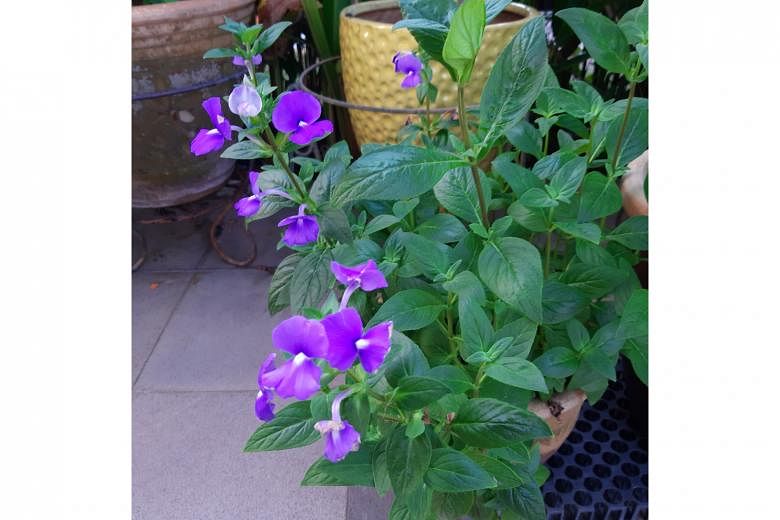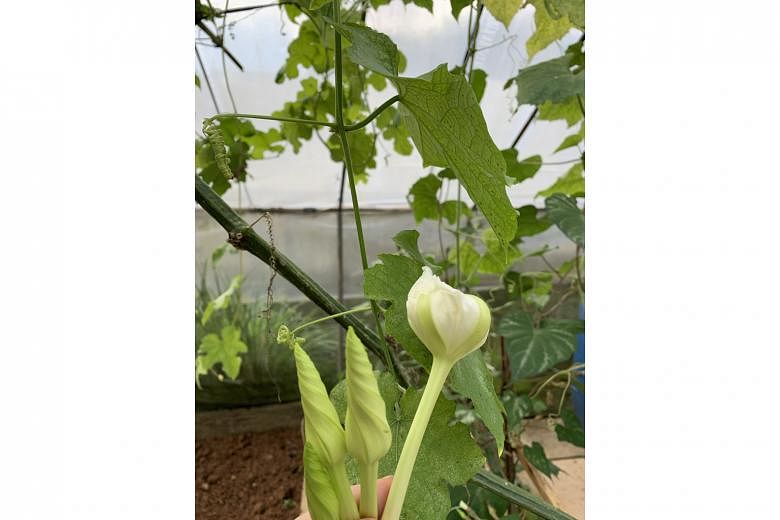Epiphyllum plant is affected by oedema
My epiphyllum plants have white stains on their leaves. What should I do?
Tay Li Lian
Your epiphyllum plant appears to be affected by a disorder called oedema, although it may be mistaken as lichen growing on it.
Oedema is a common occurrence in this group of plants - it is brought about by abnormal water retention. It can occur when the plant takes up water faster than it can lose it via transpiration. Affected tissues become corky or appear as white and crusty areas as pictured and they do not recover.
The epiphyllum plant grows as an epiphyte in its natural habitat. Ensure that you grow it in a semi-shaded area with good ventilation. This allows the root zone to dry out between each watering, which can lessen the likelihood of oedema occurring. Avoid sitting the plant in excess water.
Pomegranate, green bean plants may have spider mites
There are two types of plants in this pot. I am not sure of their names. The smaller leaves have been infected for some time, but I am not sure what insecticide to use. As for the plant with the broader leaves, it grew from scattered beans, but it is the only surviving stalk left. It was growing well and branching out with more leaves. But I saw a brown patch on the leaves two days ago. How can I restore the plants' health?
Jessica Heng
The shrub with smaller leaves appears to be a pomegranate plant (Punica granatum) and the one with larger leaves appears to be the green bean plant (Vigna radiata), judging from the growth habit and plant features.
From the symptoms seen on the leaves of the green bean plant, it appears that your plant may be infested with spider mites. These pests appear as tiny red dots where they suck sap from your plant, thereby weakening it over time.
To manage a spider mite infestation, you can spray a diluted solution of neem oil or summer oil during the cooler part of the day to kill the adult mites on the plant.
Repeated applications are necessary to remove new spider mites that hatch from eggs laid earlier. You may want to spray the foliage daily with water to wash off mites and apply the pesticide weekly to control the pest population.
It is not clear from the picture whether your pomegranate plant is infected. You may want to check for spider mites on the leaves of the pomegranate plant.
If there are distorted leaves, it could be due to damage caused by other leaf-feeding mites.
You will probably need to use a high-power magnifying glass to ascertain their presence. Neem oil or summer oil can also be used to manage these pests.
It appears your plants may be situated too low below the parapet where sunlight can be shaded. You should move your plants to a location where they can get at least four hours of direct sunlight daily.
Brazilian Snapdragon has scented leaves
What is the name of this plant? Can the leaves be eaten?
Chia Cheng Yee
The plant is botanically known as Otacanthus azureus. Its common names include Brazilian Snapdragon and Amazon Blue.
Its leaves emit a pleasant scent. The plant can be grown in a sensory garden to let visitors brush against its leaves and appreciate their scent. The leaves are not known for being suited for consumption.
The plant needs moist but well-draining soil and direct sunlight to thrive. Prune it periodically to encourage a bushier growth habit.
Flower buds, not fruit, of moonflower are edible
This plant, a gift, is growing well. I was told the buds and flowers are edible, so I fry them with eggs. They have a fragrant taste. What is the plant's name? Is the fruit edible?
Joyce Tang
The plant is commonly called the moonflower or moon vine. Its botanical name is Ipomoea alba and it is a relative of the morning glory.
It grows as a vine that produces large, white and fragrant flowers that open at night, but fade away in the morning. The blooms last longer during cooler weather and overcast days.
The moonflower is an annual plant - it loses vigour and dies after some time. Hence it is best to collect the seeds and grow the plant after the parent plant is no longer productive.
As a vine, this plant requires a support to climb on. It needs a sunny location to thrive and its soil should be moist and well-drained.
The fruit is inedible.
• Answers by Dr Wilson Wong, an NParks-certified practising horticulturist, parks manager and ISA-certified arborist. He is the founder of Green Culture Singapore and an adjunct assistant professor (Food Science & Technology) at the National University of Singapore.
• Have a gardening query? E-mail it with clear, high-resolution pictures of at least 1MB, if any, and your full name to stlife@ sph.com.sg. We reserve the right to edit and reject questions.




